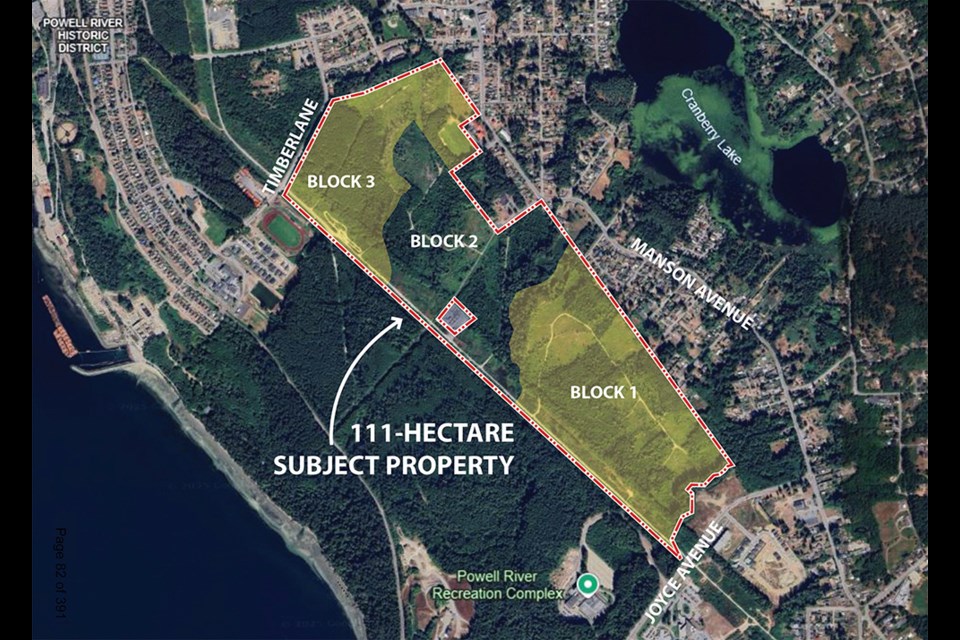City of Powell River Council has voted to direct staff to prepare draft sustainable official community plan and zoning amendment bylaws for a 111-hectare property for housing development, referred to as the Benchlands.
The parcel of land is located adjacent to Millennium Park and Powell River Recreation Complex, between Joyce and Timberlane avenues. According to a staff report at the July 3 city council meeting, the submission would further Couverdon Real Estate, a division of Mosaic Forest Management Corporation, to develop these lands with multi-lot residential subdivisions that would permit development in keeping with small-scale multi-unit housing legislation enacted by the province in 2023.
City director of planning services Jason Gow said it is worth highlighting that the lands in question are currently held as managed forest lands, and Couverdon, through Mosaic, is exploring opportunities to remove these lands from the private program for the purpose of residential development.
“The application proposes to amend the city’s official community plan and the zoning bylaw to facilitate change in land use,” said Gow. “If successful, Couverdon anticipates that the time horizon to complete a build-out of these lands to be roughly in the range of 30 years.
“The area is bigger than the residential area of Townsite and twice the size of Cranberry Lake. From a growth management perspective, these are important lands within the city, and the decisions made today will have a lasting impact on the residences of tomorrow.”
Gow said consideration of how these lands could address the community’s current and future housing needs are paramount to Couverdon’s vision. He said the community plan currently identifies three land-use designations for the subject property. The largest is designated as employment centre, followed by urban residential low density. The remaining lands are designated parks, schools and green space.
“The applicant’s current submission proposes only two land use designations – urban residential low density and parks, schools and greenspace,” said Gow. “This change would permit council to consider rezoning most of these lands to accommodate residential growth. However, removing the employment centre land use designation would impact the city’s ability to accommodate future industrial and economic growth activity on these lands.
“Staff supports a shift from industrial and economic growth to residential use for these lands.”
Gow said support for development in this location already exists. He said if council supports housing as the right fit for the entire parcel, redesignating employment centre lands to urban residential low density is a reasonable consideration.
“The urban residential low density land use designation is intended to accommodate ground-oriented residential uses with existing infrastructure and is close to recreational amenities and commercial services,” said Gow. “Acceptable housing forms include residential dwellings with or without secondary suites, and a variety of ground-oriented, multi-unit residential buildings, such as duplexes, triplexes, fourplexes and townhouses.”
Gow said based on previous council direction, staff is targeting minimum housing densities of 35 units per hectare for developments of this scale.
“Staff see a requirement to meet 35 dwelling units per hectare as modest and fair,” said Gow. “The developer will achieve much of what they want and the city will meet some of its housing-related targets.
“Staff is looking for council to endorse this level of density, as it will help further negotiations on the finer details of the proposed zoning. Staff is seeking direction to continue those negotiations and then return to council with draft amendment bylaws for consideration at a later date.”
Council carried a motion that staff be directed to prepare draft amendment bylaws to the sustainable official community plan bylaw and the zoning bylaw that would facilitate development of a 111-hectare parcel. The bylaws would be subject to a wider range of housing, and an average density of 35 dwelling units per hectare. Councillor George Doubt was opposed to the motion.
Council unanimously carried a motion to consider the amendment to the sustainable official community plan and zoning bylaw, with staff being directed to mail notifications to persons and organizations that own or occupy property within 100 metres of the boundaries of the subject properties, and to notify qathet Regional District, Tla’amin Nation and qathet School District to inform them of the proposal and solicit feedback.
Last year, Meta censored Canadian news from its feeds, so we built our own social platform: syrupsocial.com – a newsfeed powered by Canadian journalists. Join the Peak on Syrup for the latest news from the Sunshine Coast and beyond, and add the Peak's email list for the top headlines right in your inbox Monday to Friday.



